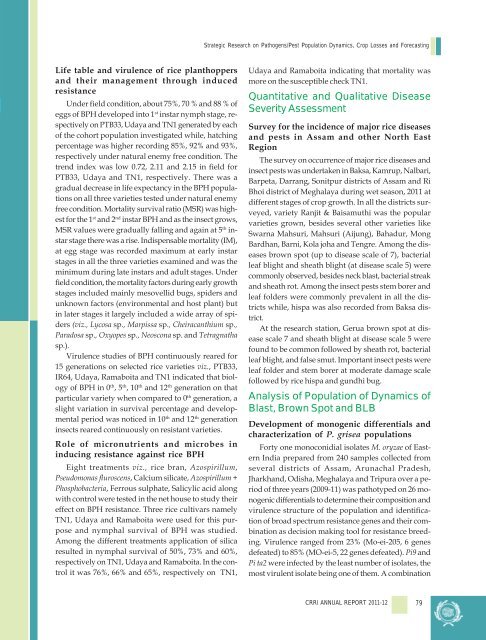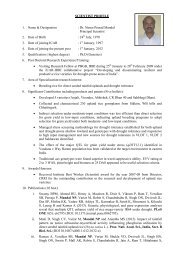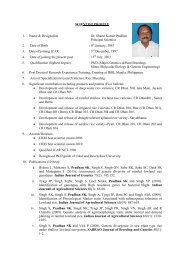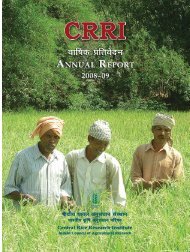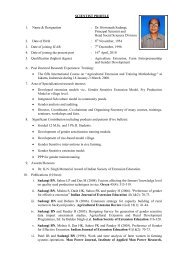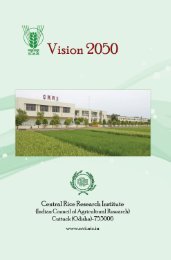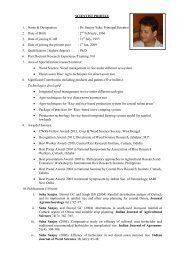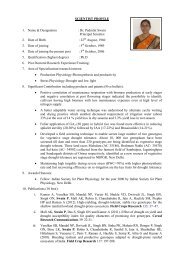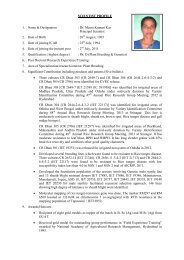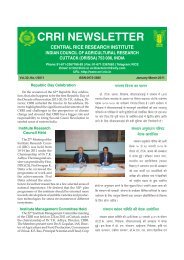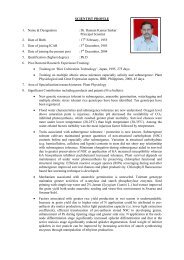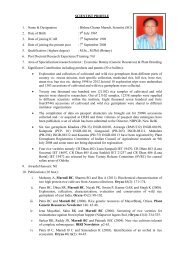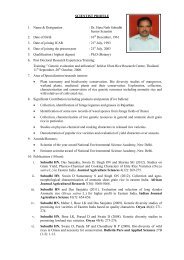Central Rice Research Institute Annual report...2011-12
Central Rice Research Institute Annual report...2011-12
Central Rice Research Institute Annual report...2011-12
You also want an ePaper? Increase the reach of your titles
YUMPU automatically turns print PDFs into web optimized ePapers that Google loves.
Strategic <strong>Research</strong> on Pathogens/Pest Population Dynamics, Crop Losses and Forecasting<br />
Life table and virulence of rice planthoppers<br />
and their management through induced<br />
resistance<br />
Under field condition, about 75%, 70 % and 88 % of<br />
eggs of BPH developed into 1 st instar nymph stage, respectively<br />
on PTB33, Udaya and TN1 generated by each<br />
of the cohort population investigated while, hatching<br />
percentage was higher recording 85%, 92% and 93%,<br />
respectively under natural enemy free condition. The<br />
trend index was low 0.72, 2.11 and 2.15 in field for<br />
PTB33, Udaya and TN1, respectively. There was a<br />
gradual decrease in life expectancy in the BPH populations<br />
on all three varieties tested under natural enemy<br />
free condition. Mortality survival ratio (MSR) was highest<br />
for the 1 st and 2 nd instar BPH and as the insect grows,<br />
MSR values were gradually falling and again at 5 th instar<br />
stage there was a rise. Indispensable mortality (IM),<br />
at egg stage was recorded maximum at early instar<br />
stages in all the three varieties examined and was the<br />
minimum during late instars and adult stages. Under<br />
field condition, the mortality factors during early growth<br />
stages included mainly mesovellid bugs, spiders and<br />
unknown factors (environmental and host plant) but<br />
in later stages it largely included a wide array of spiders<br />
(viz., Lycosa sp., Marpissa sp., Cheiracanthium sp.,<br />
Paradosa sp., Oxyopes sp., Neoscona sp. and Tetragnatha<br />
sp.).<br />
Virulence studies of BPH continuously reared for<br />
15 generations on selected rice varieties viz., PTB33,<br />
IR64, Udaya, Ramaboita and TN1 indicated that biology<br />
of BPH in 0 th , 5 th , 10 th and <strong>12</strong> th generation on that<br />
particular variety when compared to 0 th generation, a<br />
slight variation in survival percentage and developmental<br />
period was noticed in 10 th and <strong>12</strong> th generation<br />
insects reared continuously on resistant varieties.<br />
Role of micronutrients and microbes in<br />
inducing resistance against rice BPH<br />
Eight treatments viz., rice bran, Azospirillum,<br />
Pseudomonas fluroscens, Calcium silicate, Azospirillum +<br />
Phosphobacteria, Ferrous sulphate, Salicylic acid along<br />
with control were tested in the net house to study their<br />
effect on BPH resistance. Three rice cultivars namely<br />
TN1, Udaya and Ramaboita were used for this purpose<br />
and nymphal survival of BPH was studied.<br />
Among the different treatments application of silica<br />
resulted in nymphal survival of 50%, 73% and 60%,<br />
respectively on TN1, Udaya and Ramaboita. In the control<br />
it was 76%, 66% and 65%, respectively on TN1,<br />
Udaya and Ramaboita indicating that mortality was<br />
more on the susceptible check TN1.<br />
Quantitative and Qualitative Disease<br />
Severity Assessment<br />
Survey for the incidence of major rice diseases<br />
and pests in Assam and other North East<br />
Region<br />
The survey on occurrence of major rice diseases and<br />
insect pests was undertaken in Baksa, Kamrup, Nalbari,<br />
Barpeta, Darrang, Sonitpur districts of Assam and Ri<br />
Bhoi district of Meghalaya during wet season, 2011 at<br />
different stages of crop growth. In all the districts surveyed,<br />
variety Ranjit & Baisamuthi was the popular<br />
varieties grown, besides several other varieties like<br />
Swarna Mahsuri, Mahsuri (Aijung), Bahadur, Mong<br />
Bardhan, Barni, Kola joha and Tengre. Among the diseases<br />
brown spot (up to disease scale of 7), bacterial<br />
leaf blight and sheath blight (at disease scale 5) were<br />
commonly observed, besides neck blast, bacterial streak<br />
and sheath rot. Among the insect pests stem borer and<br />
leaf folders were commonly prevalent in all the districts<br />
while, hispa was also recorded from Baksa district.<br />
At the research station, Gerua brown spot at disease<br />
scale 7 and sheath blight at disease scale 5 were<br />
found to be common followed by sheath rot, bacterial<br />
leaf blight, and false smut. Important insect pests were<br />
leaf folder and stem borer at moderate damage scale<br />
followed by rice hispa and gundhi bug.<br />
Analysis of Population of Dynamics of<br />
Blast, Brown Spot and BLB<br />
Development of monogenic differentials and<br />
characterization of P. grisea populations<br />
Forty one monoconidial isolates M. oryzae of Eastern<br />
India prepared from 240 samples collected from<br />
several districts of Assam, Arunachal Pradesh,<br />
Jharkhand, Odisha, Meghalaya and Tripura over a period<br />
of three years (2009-11) was pathotyped on 26 monogenic<br />
differentials to determine their composition and<br />
virulence structure of the population and identification<br />
of broad spectrum resistance genes and their combination<br />
as decision making tool for resistance breeding.<br />
Virulence ranged from 23% (Mo-ei-205, 6 genes<br />
defeated) to 85% (MO-ei-5, 22 genes defeated). Pi9 and<br />
Pi ta2 were infected by the least number of isolates, the<br />
most virulent isolate being one of them. A combination<br />
CRRI ANNUAL REPORT 2011-<strong>12</strong><br />
79


